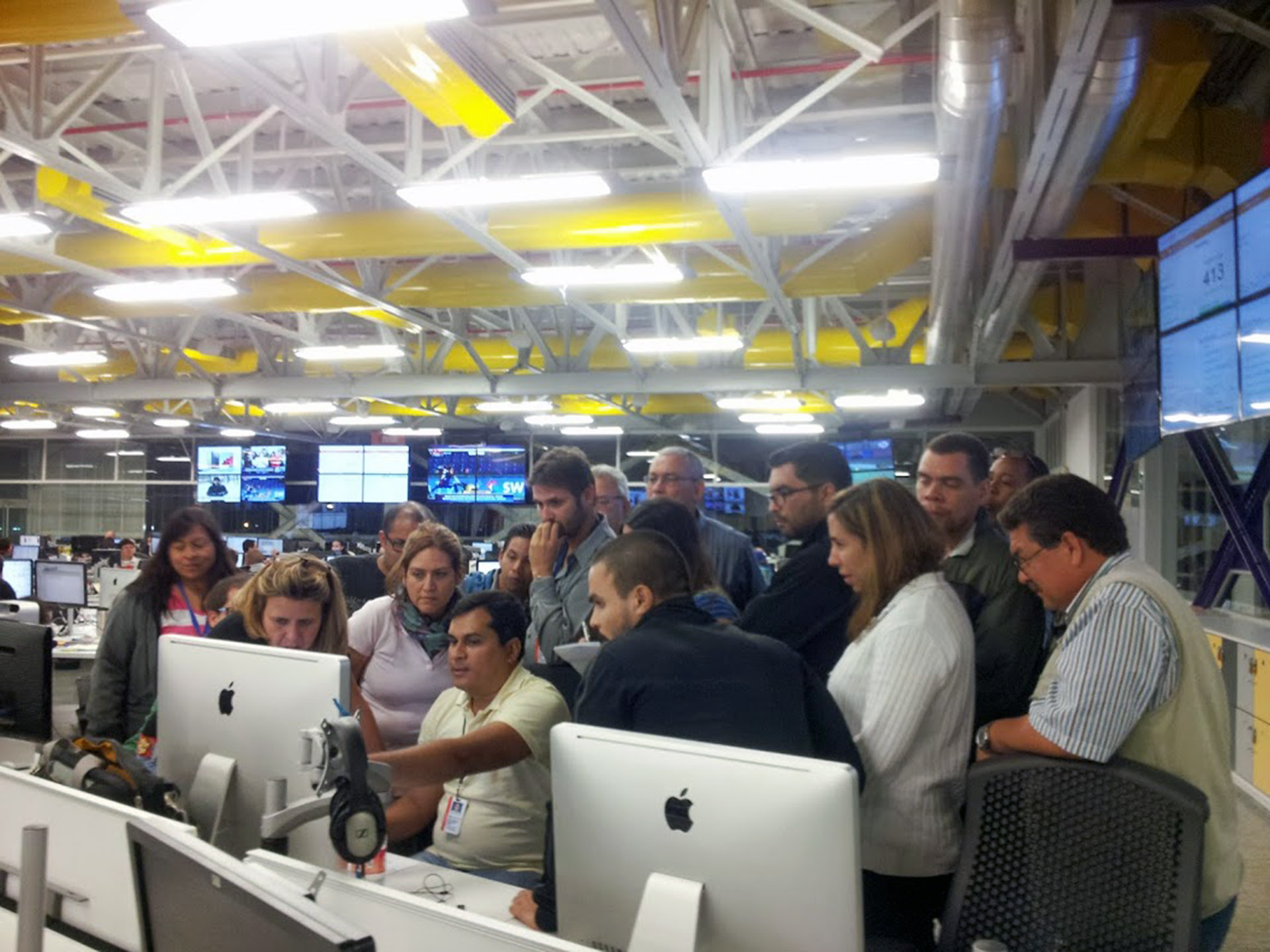

On February 12, 2014, Bassil Da Costa was killed during a demonstration against Nicolás Maduro’s government. Juancho Montoya –a leader of paramilitary groups known as colectivos– and Robert Redman completed the death toll of that day. The government blamed the opposition. But a group of investigative journalists proved, in a newspaper plagued by censorship, that the killer was a police officer assigned to SEBIN, the national intelligence service.
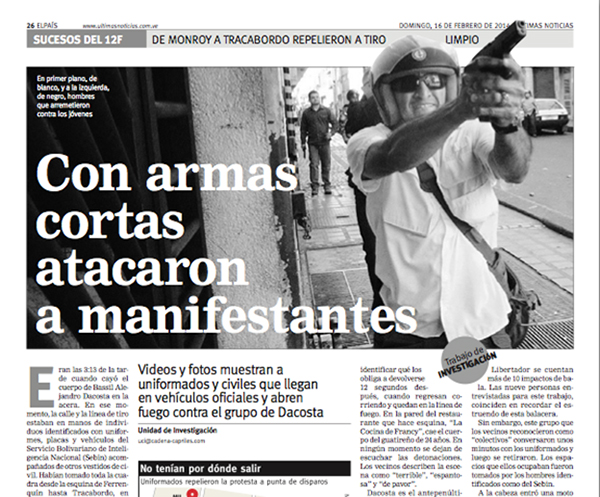 Pictures: Lisseth Boon, Andreína Mujica and David Estrada Larrañeta
Pictures: Lisseth Boon, Andreína Mujica and David Estrada Larrañeta
One picture. One hundred pictures. One image. “Two men on a powerful motorcycle.” They are in front of the demonstrators. More pictures. Coincidence: “Later, the same men cross the police cordon.” One question: who were these men?
Juan Carlos Solórzano began his workday like every afternoon. He arrived at the Últimas Noticias building, located in La Urbina, to the east of Caracas, and went to the video department where he worked. It was February 12, 2014. A Wednesday.
The opposition had called a mobilization against Nicolás Maduro, on the occasion of Día de la Juventud (Youth Day). The call began to gain strength after the detention of some students in the states of Táchira and Mérida the week before. The demonstration started in Plaza Venezuela and was heading to the Fiscalía General (the national prosecutor’s office) on Avenida Universidad. Accompanied by the opposition leader, Leopoldo López, the protesters arrived at the headquarters of the Public Ministry, sang the national anthem and demanded the release of their fellow students from the Andean region.
When the march finished, a small group lingered. Those who stayed behind walked to Monroy corner and then went up towards Tracabordo corner, where they pushed a motorcycle belonging to Sebin, the national intelligence service. This incident unleashed the fury of the Sebin officers, who began to shoot at the demonstrators. They ran, some towards Avenida Universidad and others towards a side street. The second group of protesters returned a few seconds later – 12 seconds exactly, according to the reconstruction of events made by the Últimas Noticias’ Research Unit. This group was caught in the firing line. At 3:13 pm, Bassil Da Costa fell face down on the sidewalk. At 3:25 pm, this 24-year-old man was admitted to the Vargas Hospital dead, shot in the head. It was the first time he had attended a protest.
That night, Robert Redman, a 31-year-old pilot was also killed outside his apartment in Chacao, during another outbreak of protest. He was among those who, hours earlier, had carried Da Costa’s lifeless body.
When Solórzano arrived at the newspaper, these events were already in progress. He was struck by the videos that were circulating on social networks and the material that photojournalists brought in, where some Sebin officers appeared opening fire. On Twitter, there was a video in which an officer was triggering a handgun. This officer was accused of killing Da Costa.
But Solórzano did not trust rumors circulating on social networks. It was not possible to see who was being shot. He remembered what happened after April 11, 2002, and he thought they could incriminate someone without having all the elements. It was at that moment when the videographer began to see all the material that was spreading on the web, to review pictures and to compare the hours in which they had been taken. He saw more than a thousand pictures.
Something caught his eye. He saw some men on a high-powered motorcycle, in front of the march that was heading towards La Candelaria. Some other pictures showed the same men cross the police cordon. There was a revealing detail: the police opened the way for them.
Tamoa Calzadilla directed Últimas Noticias’ Research Unit until March 17, 2014. She resigned in protest for the censorship that prevented the publication of a story from a journalist on her team, Laura Weffer. Cadena Capriles, the editorial group that also published the newspapers El Mundo, Economía y Negocios, and the sports magazine Líder, had been sold on May 31, 2013. The name of the buyer was not revealed. However, changes on the editorial line that, from that day, began to favor the government, indicated the new owners’ alliances. Those were the reasons why Calzadilla left the company where she had worked for 15 years. But exactly one month before resigning, she would undertake the investigation that unmasked, the same week of the events, the official version about the death of Bassil Da Costa.
They were all in the newsroom. Social networks were their partners this time, although Calzadilla remembers not trusting them for all the disinformation that was circulating that day. On Twitter, it was rumored that there were many dead. That’s why Calzadilla asked Airam Fernández, another reporter from her research unit, to go to the Vargas Hospital, where they said Bassil Da Costa was taken. One of Da Costa’s cousins thought he was dead.
This was the first thread they began to pull to untangle the web, in order to weave the fabric for the story they would be publishing the next Sunday. That, and a conversation that was about to happen.
Calzadilla bumped into someone from Solórzano’s team, who asked her what they would do about the events of that day. She replied that they were still thinking about how to approach the issue.
“Juan Carlos Solórzano is at his computer reconstructing with images what happened,” was the answer.
The press room of the Cadena Capriles was called Redacción Única –Single Newsroom– after the move from the Torre la Prensa –Press Tower. It is a wide space were journalists, photographers, infographers and editors from all the brands of the editorial group, now called UN, work together. The video department is located on a couple of long desks, just meters from the women’s restroom, and close to the research area of the Unidad Centralizada de Información, UCI, the Centralized Information Unit.
Calzadilla went to talk to Solórzano without a second’s hesitation. She asked him to work together and he showed her what he had found.
In a few hours, the videographer had gathered audiovisual material from different sources. From newspaper photographers, pictures and videos from other media, videos and images from Twitter. Different angles of the same event: men dressed in civilian clothes, but with features of police officers, firing at the demonstrators, protected by the police forces.
With great care, they undertook the curatorship of the images. Solórzano, who was extremely meticulous, said: “Look at this person’s shoes. Now look at these. They are the same shoes of the person who is shooting, and they are also the same ones of the person who leaves on the motorcycle.”
In this way, they began to see who had been at the crime scene. Given the immense amount of photos and videos that people had uploaded to the networks, they said: “We are going to protect everyone’s identity; what we are going to say here is very dangerous.”
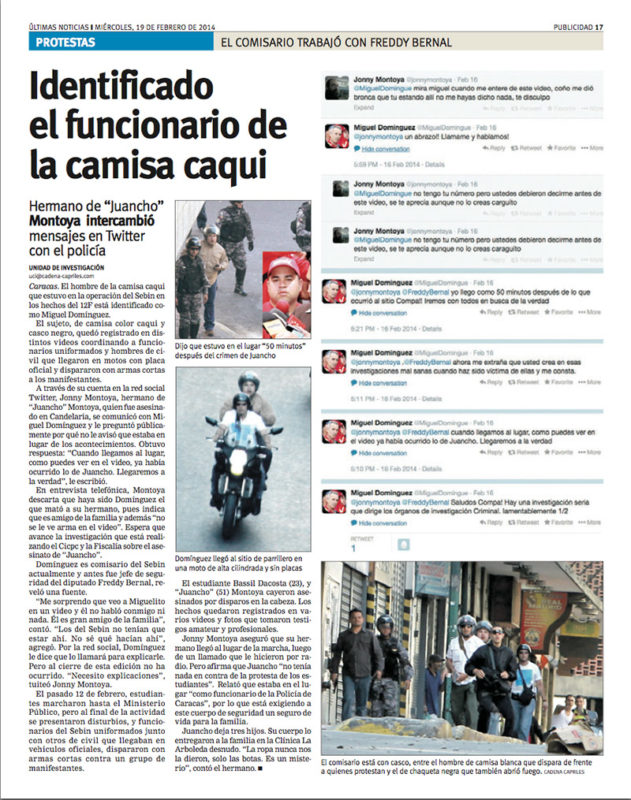
How would they prove their suspicions? The other phase of the investigation was about to begin.
César Bátiz was coordinator of the UCI of Últimas Noticias until April 29 of that year, when he resigned, a month and a half after Calzadilla, and for the same reasons. He was the second member of the team to know about Solórzano’s work.
Bátiz remembers that, on that day, Desirée Santos Amaral, a journalist who briefly served as editorial counselor after the sale of the newspaper, was in the newsroom saying that “the opposition was going to repeat what happened on April 11.” He also remembers Calzadilla’s insight when she decided to begin an investigation based on the analysis that Solórzano had started. They determined that the material from the social networks was not enough, so they sent Laura Weffer to the place where Da Costa died, to collect testimonies and compare the reality with the photographs. On each street, each corner, in each building, the images were revealing the undeniable forcefulness of the facts.
Bassil Da Costa was not the only victim that day. Minutes before, a few meters away, a bullet entered through the nostril of Juan (Juancho) Montoya, who was the coordinator of the Revolutionary Secretariat of Venezuela, which unites the popular colectivos of Caracas and Vargas state. He was already dead when he arrived at the La Arboleda clinic.
That same afternoon, Diosdado Cabello, vice president of the National Assembly at that moment, said: “Fascism was there, at Plaza Candelaria, and they were hunting him (Montoya). A worthy comrade, a fighter, the leader of the colectivos of the 23 de Enero neighborhood. He was vilely assassinated by fascism.” And he added: “We ask the colectivos for calm and sanity. This is a provocation from the right. But those responsible are going to fall, whatever they are called, and wherever they hide. For how long are these fascist assassins going to call for violence? They are murderers.”
So now, the official version pointed to the opposition as the culprit of the events of February 12.
Calzadilla had received a message, from a source, that assured her Montoya did not belong to a colectivo, but he was an undercover Cuban agent. She told Bátiz this, because it seemed strange. Then she decided that someone had to go to the wake, in the 23 de Enero neighborhood. Talk to relatives, see if there was someone crying there, if Montoya was really from 23 de Enero.
The reporter responsible for the dangerous task of verifying the information was Carjuan Cruz. She discovered that the person who had written to Calzadilla was lying, throwing the lure of false information to be published. Cruz confirmed that she saw and talk to Montoya’s mother and sister at the wake. What was said about Montoya was true. He was a leader of colectivos.
Laura Weffer worked at the UCI of Últimas Noticias until 2014, when her story “What’s behind the guarimbas“, scheduled to be published on March 16, was censured. To justify his decision, the director of the newspaper, Eleazar Díaz Rangel, said: “After reading and making several observations, I remained convinced that (…) in those conditions the story could not be published. It was a celebration of the guarimba.”
One month before, together with Solórzano, Weffer was in charge of reporting on the site where Bassil Da Costa was killed, to verify the hypothesis that the investigation team had raised, and that now challenged the government’s version: Da Costa had been assassinated by state officials.
That day, the neighbors provided them with more than 100 photos and 8 or 10 videos. Without the disposition of the people, Weffer believes now, they could not have discovered the truth.
In one of the buildings where they entered, someone told them: “I have something.” A student had a very well-made photographic sequence, taken with a good camera. He had a telephoto lens, which allowed him to shoot what happened accurately. He showed them all the pictures. The first thing they saw was the men on the motorcycles (who were dressed as civilians), and who came down with the group of officials on the same street.
It was the first clue of the day.
Later, at the newsrooom, and with a cold head, Solórzano was scanning Facebook and noticed that someone had shared a picture of one of the plainclothes officers on a friend’s wall. The man was firing. Solórzano downloaded the photo, analyzed it and placed the man in the videos.
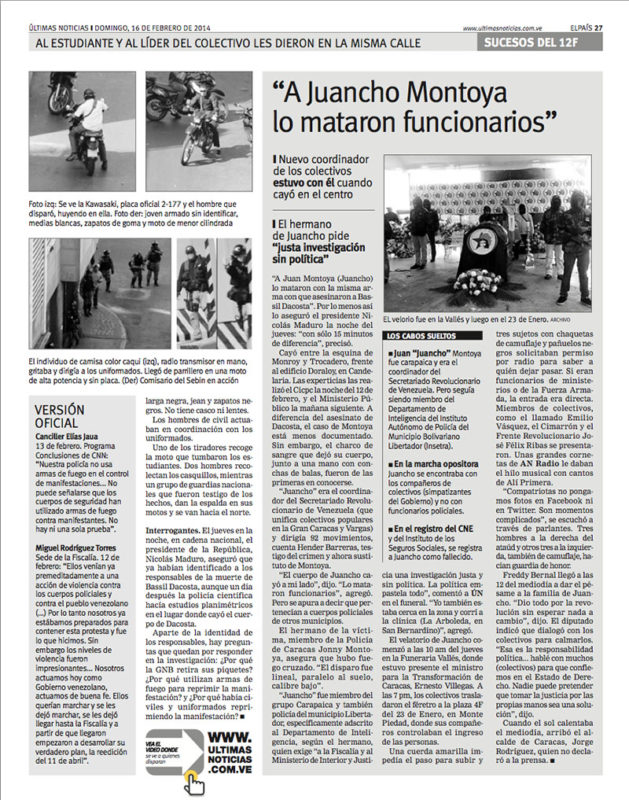
This picture of a man with a helmet, dark glasses, green bag and military green trousers, was the image that opened the gate for the rest of the story.
Solórzano and Weffer gathered a lot of information. On Thursday 13 they received more pictures, they confirmed the time in which the police command had arrived, the time when they had fired, when the wounded had fallen and when the officials had retired, backed by the National Guard. People even told them that on the night of February 12, Sebin officials had gone to collect casings and to confiscate cameras of those who had registered the incident.
With all the information verified, they began to put together the complex puzzle that would support the story.
They decided to make a video, with the chronology of the death of Bassil Da Costa. A picture preserved that moment in which Solórzano was editing the video, surrounded by the whole team. The photo was taken by Lisseth Boon, another journalist from the research unit, who participated in data verification with Airam Fernández and Albinson Linares.
The written story contained what was already in the video. This gave them the opportunity to use a direct language, without assumptions, because the video was compelling. Irrefutable.
Tamoa Calzadilla presented that written piece to Eleazar Díaz Rangel on Friday 14. They were in the middle of a terrible censorship situation. Cadena Capriles had already been bought by unknown people, adopting a clear pro-government editorial line.
At minute 3:41 of the audiovisual material that supported the investigation, an image shows three key subjects: the man in a white shirt, the man in a khaki shirt (as they were called by the reporters) and a third, in a brown shirt. Among them was Da Costa’s killer.
“Director,” said Calzadilla, “we have a very strong story, but we have all the evidence. It was the Sebin who shot the demonstrators, and they are responsible for the death of Bassil Da Costa.”
The expression in Díaz Rangel’s face changed. He asked for a few minutes to think.
“When I returned to his office,” said Calzadilla, “he told me he had called the Attorney General, Luisa Ortega Díaz, to tell her about the story we were going to publish on Sunday.”
That February 16, under the title “Events of February 12: with handguns they attacked protesters”, the story was made public, in the press and on the digital portal. In a few hours it was the most seen story of the page. And the video was reproduced by thousands of people through social media.
At 9:30 am, state officials and the new owners of the editorial group began to press for the removal of the material from the web. It was impossible. It was already viral. The story was removed from the highlights, but its dissemination did not diminish.
At around 4:00 pm, Nicolás Maduro delivered a clear message on radio and television: “A group of Sebin troops disregarded the order to remain in the barracks.” The President of the Republic had recognized that these had been the murderers.
Calzadilla was with her family that Sunday. While the others talked outside, she remained in a room in front of the television. She was trembling, seeing what was happening. That Maduro admitted what they had demonstrated was very important. She also felt great relief. The government could have invented anything about the journalists or the story they were telling.
The possibility of stopping an injustice was what drove the investigation. That was the kind of journalism they were dedicated to: exposing what power wants to hide. But results are not always as definitive as this one.
In the following days, the suspects were identified. The man in the white shirt was Jonnathan Rodríguez Duarte, a third sergeant in the Army and escort of the then Minister of the Interior, Justice and Peace, Miguel Rodríguez Torres. He was the man firing a 9mm handgun (Glock 19) in all the videos. The man in the khaki shirt was José Miguel Domínguez, “Miguelito”, security chief of deputy Freddy Bernal, who at the time was leading the Presidential Commission for the Transformation of the Police System. Domínguez directed the operation. The man in the brown shirt was identified as José Ramón Perdomo Camacho, a Sebin officer and actual perpetrator of the murder of Da Costa.
While they were covering all the incidents of the case, Rodríguez Torres sent a message to Laura Weffer through Díaz Rangel: “Tell Laura to stop fucking around.”
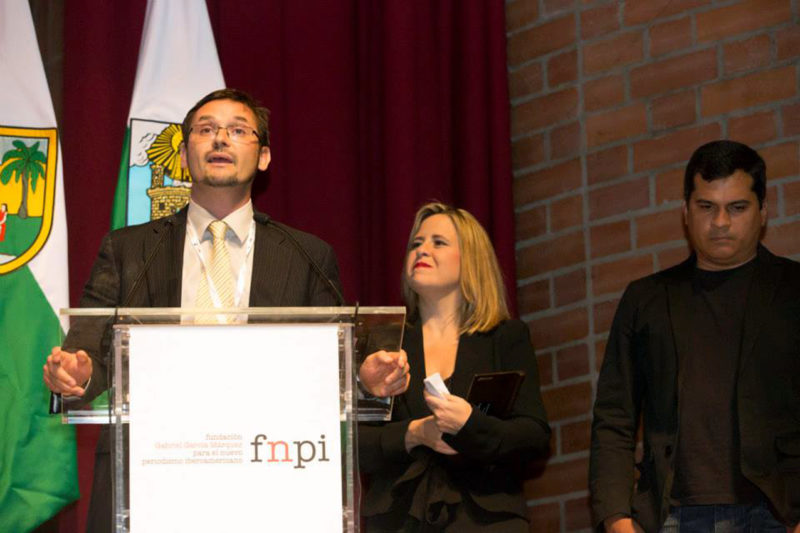
On February 25, the 48th Control Court of the Metropolitan Area of Caracas ordered the arrest, due to their involvement in the death of Bassil Da Costa, of the Chief Commissioner Manuel Benigno Pérez; the deputy commissioner Edgardo José Lara Gómez; the inspector Héctor Andrés Rodríguez Pérez; and detectives Josner Márquez Fernández and Jimmy Alexis Sáez Osorio. All of them Sebin active officers.
On March 28, 2014, the judicial police determined that the perpetrator of the murder of Da Costa was José Ramón Perdomo Camacho, 42, also a Sebin officer. He was sentenced to 29 years and 6 months in prison, on December 1, 2016. Andry Yoswua Jaspe López, 28, was sentenced to 6 years in prison for the improper use of a service firearm. The other Sebin officials were let off.
Perdomo Camacho said, in his statement, that he never received an order to remain in the barracks.
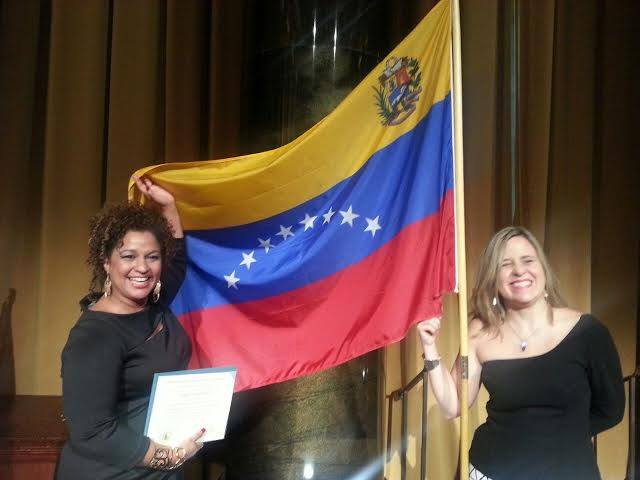
The story, published in a series between Sunday 16 and Sunday 23 of February, 2014, won the national Ipys-Venezuela 2014 investigative journalism award and the Gabriel García Márquez international journalism prize. In 2014, Calzadilla and Weffer also received a special mention in the Maria Moors Cabot Prize, the oldest award in the United States, issued by Columbia University. Both journalists were photographed with a Venezuelan flag during the ceremony.
The facts demonstrated by the investigation also prevented the accusation that opposition leader Leopoldo López was the mastermind behind the murders of that day.
Tamoa Calzadilla is now working as investigative journalist and as a member of the special projects unit at Univisión Noticias. Juan Carlos Solórzano emigrated to Central America. Carjuan Cruz lives and works in Miami, Florida. César Bátiz is founder and director of the digital newspaper El Pitazo. Laura Weffer is editorial director and cofounder of the news portal Efecto Cocuyo. Lisseth Boon works at the portal Runrunes. Albison Linares now lives in Mexico and Airam Fernández in Chile.
The only journalists of this group who continue living in Venezuela are Bátiz and Boon. After the resignation of each one of its members, the Últimas Noticias’ Research Unit was closed.
Translation: Raquel Rivas Rojas (edited by Katie Brown)
3096 readings
I pretended to be a reporter as soon as I learned to read. Later on, I considered pursuing a career in five other professions. But life wanted me to be a journalist. I knew it when I was 12 years old. I was born the day I started covering minor league sports and fell in love with communities. Now I am learning to tell their stories.